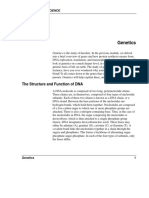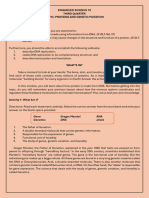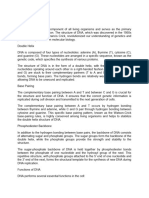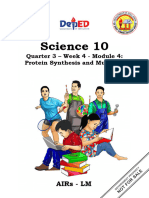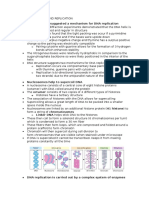Dna Review Answers
Dna Review Answers
Uploaded by
Shi JieCopyright:
Available Formats
Dna Review Answers
Dna Review Answers
Uploaded by
Shi JieCopyright
Available Formats
Share this document
Did you find this document useful?
Is this content inappropriate?
Copyright:
Available Formats
Dna Review Answers
Dna Review Answers
Uploaded by
Shi JieCopyright:
Available Formats
DNA and Protein Synthesis Review ANSWERS!!! 1. What are nucleotides? Describe their structure.
They are the monomers (building blocks) of nucleic acid. They are made up of a 5-carbon sugar (ribose in RNA or deoxyribose in DNA), a phosphate, and a nitrogen base (A, C, G, T [DNA] or U [RNA]). The sugar and phosphate make up the backbone of the structure. The nitrogen base is bonded to the sugar. 2. Summarize the Hershey and Chase experiment and explain what their results suggested. The Hershey-Chase blender experiment: - Took viruses called a bacteriophages (will infect bacteria) and labeled their protein with heavy sulfur (35S). The bacteriophages infected the bacteria. After centrifugation, the radioactive protein was found to be in the supernatant, NOT in the pellet with the bacteria. - Labeled the nucleic acid of the bacteriophage with heavy phosphorus (32P) and carried out the experiment as stated above. The radioactive phosphorus was found in the pellet, which indicated that it was injected into the bacteria. - Hershey and Chase concluded that the viral DNA was the genetic material, not the protein, that was taking over the bacteria. 3. Chargaff made an important contribution to uncovering the structure of DNA. What were his findings and what do they indicate? He found that in every species that he studied, if there were a certain number of adenines, then there was an equal number of thymine. The same was true for guanine and cytosine. This indicated that A must bond with T and C with G.complementary base pairing! 4. Who proposed the double helix model for the DNA molecule? Watson and Crick 5. Describe how DNA and RNA differ in their composition, structure, function, and location. Nucleic Acid DNA RNA Composition Deoxyribose thymine Ribose uracil Structure double helix single segments or strands Function Master blueprint Ex. mRNA, tRNA, primer during DNA replication Location nucleus Mainly outside the nucleus
6. What is meant when we say that DNA replication is complementary? A-T,C-G 7. Why is DNA replication important for every cell? Each daughter cell needs a complete set of DNA in order to properly functionb. 8. Compare the amount of DNA in a muscle cell with that in a brain cell. It is the exact same. 9. What is meant by saying that DNA replication is semi-conservative? Each daughter molecule has one parent (old) strand and one daughter (new) strand. 10. Briefly describe the steps in DNA replication. Here we go - Helicase unwinds the DNA, and the replication fork is held open by single-strand binding proteins. - DNA polymerase III creates a daughter strand of DNA in the 5 to 3 direction via complementary base pairing. - The leading strand is formed in a simple, continuous fashion. The lagging strand is formed via segments called Okazaki fragments.
- To create the lagging strand, primase creates and RNA primer from which DNA polymerase III will then create an Okazaki fragment in the 5 to 3 direction. - When the DNA polymerase III reaches the RNA primer of a previous Okazaki fragment, it detaches and DNA Polymerase I bonds to the nucleic acid and replaces the RNA primer with DNA. - The gap between the two Okazaki fragments is then sealed by ligase. 11. Why is replication on one strand of DNA continuous, while on the other strand the replication must be discontinuous? The strands of DNA are antiparallel and complementary strands can only be constructed in a 5 to 3 direction. At the 3 end there is a free hydroxyl group and in order to bond the next nucleotide (which, while floating in the cytosol, has three phosphates in total!!), two phosphates have to be lost so that the energy released can be used to form a bond. This bond forms between the remaining phosphate and the terminal sugar on the growing daughter strand. 12. What functional group is at the 5' end of a DNA molecule? Phosphate 13. Proofreading enzymes scan DNA to check for base pairing errors. Explain why these enzymes are important. They minimize the number of mutations when replicating the DNA. 14. Why is the making of exact copies of DNA called replication rather than duplication? Because calling it DNA duplication would make it sound like the parent DNA strands stays together and that the new DNA is entirely made of daughter DNA. This terminology would support the CONSERVATIVE model, not the SEMICONSERVATIVE model! 15. If human DNA contains approximately 3x109 base pairs, and DNA polymerase can work at the rate of about 50 nucleotides per second, how can our DNA be replicated so quickly? There are a number of origins of replication; replication will occur in both directions within a replication bubble AND on both strands, all at the same time! 16. If 27 percent of the bases in a certain segment of DNA were adenine, what would be the percentages of thymine (27%), cytosine (23%), and guanine (23%)? 17. A segment of chromosomal DNA which contains instructions for one protein is a ____gene_________. 18. Describe the technique of DNA fingerprinting. Since DNA contains some sequences that are unique to individuals, this information can be used to identify someone just like a regular fingerprint can. Restriction enzymes are used to cut the DNA of an individual at specific sites such that they have DNA divided into varying lengths. These segments of DNA are then divided during a process called gel electrophoresis, and the pattern of the bands in the gel is unique to one person. 19. As a research biologist, you know of a bacterium that produces an antifungal treatment that is quite effective against a certain crop plant fungus. There would be great economic importance in enabling the plant to resist the fungus. How might you use DNA technology to accomplish this? Using recombinant DNA!! The bacterial DNA coding for the antifungal treatment is inserted to the plant DNA. The resulting plant will be resistant to the fungus.
You might also like
- Fairy Tales Transformed Twenty First CenDocument6 pagesFairy Tales Transformed Twenty First CenJaimirton GomesNo ratings yet
- Pessoa, Fernando - Collected Poems of Alvaro de Campos, Vol. 2 (1928-1935) (Shearsman, 2009)Document191 pagesPessoa, Fernando - Collected Poems of Alvaro de Campos, Vol. 2 (1928-1935) (Shearsman, 2009)Diego Dituri83% (6)
- DNA StructureDocument4 pagesDNA StructureMaybella PruntyNo ratings yet
- Safe Handling of AsbestosDocument124 pagesSafe Handling of AsbestosMarcelo Gil SimõesNo ratings yet
- Plane Figures MathDocument9 pagesPlane Figures MathIan Christian Alangilan BarrugaNo ratings yet
- Exercise 1: Group A VocabularyDocument2 pagesExercise 1: Group A VocabularyКостя ГарасьNo ratings yet
- Elite G11 Biology Exam Coverage Practice T3 22-23: Chemical Building Blocks Called NucleotidesDocument29 pagesElite G11 Biology Exam Coverage Practice T3 22-23: Chemical Building Blocks Called NucleotidesMahra AlketbiNo ratings yet
- DNA Replication Review WorksheetDocument8 pagesDNA Replication Review WorksheetSamya SehgalNo ratings yet
- Designer Genes: Practice - Molecular-Genetic GeneticsDocument26 pagesDesigner Genes: Practice - Molecular-Genetic GeneticsGiovanni TorresNo ratings yet
- FOR FINALDocument29 pagesFOR FINALAbdul macaampaoNo ratings yet
- DNA Structure & ReplicationDocument25 pagesDNA Structure & Replicationivanam0202No ratings yet
- Study Guide - Topic 1 - Genetic Material - Objective 1,2,3Document6 pagesStudy Guide - Topic 1 - Genetic Material - Objective 1,2,3charidellozano19No ratings yet
- Combine PDFDocument106 pagesCombine PDFМөнхгэрэл ГанбатNo ratings yet
- DNA Definition, Characteristics & SequencingDocument5 pagesDNA Definition, Characteristics & SequencingAswathy BommiNo ratings yet
- MolecularDocument4 pagesMolecularalvinaNo ratings yet
- Science10 Q3 Week4Document22 pagesScience10 Q3 Week4Samad Recca T. NatividadNo ratings yet
- Notes - Dna Protein Synthesis - Student 2000Document14 pagesNotes - Dna Protein Synthesis - Student 2000api-270403367No ratings yet
- DNA ReplicationDocument3 pagesDNA ReplicationGirish AdapaNo ratings yet
- Earth and Life Science. Chapter 7Document21 pagesEarth and Life Science. Chapter 7veronicaNo ratings yet
- Lesson-3 Protein-Synthesis WorksheetDocument10 pagesLesson-3 Protein-Synthesis WorksheetEnriquez, Hannah Roniella R.No ratings yet
- Genetic EngineeringDocument218 pagesGenetic EngineeringSrramNo ratings yet
- Chapter 7: Nucleic Acids: 7.1: DNA Structure and ReplicationDocument5 pagesChapter 7: Nucleic Acids: 7.1: DNA Structure and ReplicationMariamNo ratings yet
- Chapter-6 Molecular Basis of InheritanceDocument17 pagesChapter-6 Molecular Basis of Inheritanceshodhan shettyNo ratings yet
- 10RepAMO SuarezDocument21 pages10RepAMO SuarezscasuarezNo ratings yet
- Chapt 7 DNA Replication NotesDocument8 pagesChapt 7 DNA Replication Notesmalenya1100% (1)
- Heredity Inheritance and Variations PDFDocument56 pagesHeredity Inheritance and Variations PDFNoean LargoNo ratings yet
- The Structure of DNADocument3 pagesThe Structure of DNAkalaysiahart01No ratings yet
- Chapter 6 Molecular Basis of InheritanceDocument4 pagesChapter 6 Molecular Basis of Inheritancelavishbhati691No ratings yet
- DNA, RNA and ProteinDocument30 pagesDNA, RNA and Proteinsiti sarah amandaNo ratings yet
- Chapter 12 Biol1010 Notes-1-1Document4 pagesChapter 12 Biol1010 Notes-1-1yazst.julienNo ratings yet
- Genetics 1Document13 pagesGenetics 1Shivam PatelNo ratings yet
- Study Guide BiologyDocument8 pagesStudy Guide BiologyBayron SaucedaNo ratings yet
- Lecture Notes 8Document5 pagesLecture Notes 8rishabhNo ratings yet
- DNA Structure and ReplicationDocument15 pagesDNA Structure and ReplicationYuli HdyNo ratings yet
- CBSE Class 12 Biology Revision Notes Chapter 6 Molecular Basis of InheritanceDocument10 pagesCBSE Class 12 Biology Revision Notes Chapter 6 Molecular Basis of InheritancesahanaNo ratings yet
- Molecular Basis of InheritanceDocument55 pagesMolecular Basis of InheritancePRAVEENKUMARJADHAVNo ratings yet
- Rhondene Wint Foundation of Biology 155 Section A Lab 3 Lab Instructor: Dian Griffiths Northern Caribbean UniversityDocument6 pagesRhondene Wint Foundation of Biology 155 Section A Lab 3 Lab Instructor: Dian Griffiths Northern Caribbean UniversityRhondene WintNo ratings yet
- Nucleic acidsLECTUREDocument116 pagesNucleic acidsLECTUREKesha Marie TalloNo ratings yet
- Chapter Twelve: DNA Replication and Recombination: Comprehension QuestionsDocument13 pagesChapter Twelve: DNA Replication and Recombination: Comprehension QuestionsJeevikaGoyalNo ratings yet
- DNA ReplicationDocument32 pagesDNA ReplicationSudipta MandolNo ratings yet
- Lecture 2Document48 pagesLecture 2KrishNo ratings yet
- Composed of A BaseDocument23 pagesComposed of A Basetanvi bhallaNo ratings yet
- molecular basisDocument11 pagesmolecular basismailtomsreeNo ratings yet
- Module 4Document30 pagesModule 4Jesusa GalangNo ratings yet
- Bio FinalDocument8 pagesBio FinalChris SmithNo ratings yet
- Solutions Manual Chapter 12Document17 pagesSolutions Manual Chapter 12Lú Lạ LẫmNo ratings yet
- Biochem Task 9 BocalanbethinnaDocument4 pagesBiochem Task 9 BocalanbethinnaANA MARIA BETHINNA BOCALANNo ratings yet
- Structure of DNA Science Presentation in Light Blue Green Lined Style 20240314 1Document26 pagesStructure of DNA Science Presentation in Light Blue Green Lined Style 20240314 1leighariazbongsNo ratings yet
- Nucleic Acids BC21C 2018 StudentDocument120 pagesNucleic Acids BC21C 2018 StudentPheona BlagroveNo ratings yet
- BIOTECH 2Document14 pagesBIOTECH 2nadaellithyNo ratings yet
- InstructionsDocument5 pagesInstructionsLord NiquidNo ratings yet
- REPLICATIONDocument9 pagesREPLICATIONdineshNo ratings yet
- 7 - DNA Protein Synthesis Study GuideDocument2 pages7 - DNA Protein Synthesis Study Guideelursgod1No ratings yet
- Taller DNA RespuestasDocument6 pagesTaller DNA Respuestasdanielbotero721No ratings yet
- Module 4 KKKDocument32 pagesModule 4 KKKbhrayancachero100% (1)
- CHAPTER 8 - The DNA - Structure, Function, and DiscoveryDocument18 pagesCHAPTER 8 - The DNA - Structure, Function, and Discoverybabylen bahalaNo ratings yet
- Nucleic Acids NOTESDocument8 pagesNucleic Acids NOTESelaineNo ratings yet
- STPM Biology DNA Structure and Replication Question BankDocument6 pagesSTPM Biology DNA Structure and Replication Question BankMichele Goh100% (4)
- Ch-6 (Notes)Document14 pagesCh-6 (Notes)Sourav DasNo ratings yet
- Topic 1 - A1.2 Nucleic AcidsDocument63 pagesTopic 1 - A1.2 Nucleic AcidsOlatundeNo ratings yet
- DNA ReplicationDocument6 pagesDNA ReplicationGeorge TarraNo ratings yet
- Chapter - Biology Xii PyqDocument16 pagesChapter - Biology Xii Pyqalina jamalNo ratings yet
- G.R. No. L-42032 January 9, 1976 de Gracia V. Warden of MakatiDocument1 pageG.R. No. L-42032 January 9, 1976 de Gracia V. Warden of MakatiBer Sib JosNo ratings yet
- Rationally-Based Structural Design: An IntroductionDocument11 pagesRationally-Based Structural Design: An IntroductionMuhammad AhmedNo ratings yet
- Application Form Account Opening26112021014636Document4 pagesApplication Form Account Opening26112021014636TECH 9tvNo ratings yet
- University of Toronto Press: Constructing HealthDocument1 pageUniversity of Toronto Press: Constructing Healthanon_273628462No ratings yet
- ONG V ONG G.R. No. L-67888 - October 8, 1985 - Relova, J. TOPIC: False Consideration Summary: Ruling of The Lower CourtsDocument2 pagesONG V ONG G.R. No. L-67888 - October 8, 1985 - Relova, J. TOPIC: False Consideration Summary: Ruling of The Lower CourtsIldefonso Hernaez100% (1)
- Ople Vs TorresDocument3 pagesOple Vs TorresSarah Jane UsopNo ratings yet
- Wreck of Hesperus AnalysisDocument9 pagesWreck of Hesperus Analysisapi-257262131No ratings yet
- Theoriess - Mr. BajetDocument61 pagesTheoriess - Mr. BajetMaria Cristina DelmoNo ratings yet
- 2021 LGCSE Perfomance by CentreDocument8 pages2021 LGCSE Perfomance by CentretshepomoejanejrNo ratings yet
- 7.2 Kernel and Image of A Linear TransformationDocument11 pages7.2 Kernel and Image of A Linear TransformationJason Andres Diaz SuarezNo ratings yet
- Local History of LibmananDocument29 pagesLocal History of LibmananJohn Carlo NolascoNo ratings yet
- Makkan and Madani Life of Prophet PDFDocument11 pagesMakkan and Madani Life of Prophet PDFZeeshan Syed75% (4)
- Possessive AdjectivesDocument3 pagesPossessive AdjectivesKenert Quispe TiconaNo ratings yet
- Pengertian Gambit Dan Contoh ContohnyaDocument4 pagesPengertian Gambit Dan Contoh ContohnyaNUR ASYSYIFAANo ratings yet
- Kolb Learning StylesDocument7 pagesKolb Learning StylesGaurav Waghmare0% (1)
- RPP SDDocument7 pagesRPP SDGina SalsabilaNo ratings yet
- My IndiaDocument2 pagesMy IndiacerrungNo ratings yet
- 16 Bài Tập Đột Phá Tư Duy Đọc HiểuDocument96 pages16 Bài Tập Đột Phá Tư Duy Đọc HiểuLan Nguyen100% (1)
- Divine Light Academy: NameDocument2 pagesDivine Light Academy: NameRobyNo ratings yet
- Asf PR1Document10 pagesAsf PR1Norryne Myla N. NovidaNo ratings yet
- Exotic Interest-Rate Options: Marco MarchioroDocument66 pagesExotic Interest-Rate Options: Marco MarchioroVishalMehrotraNo ratings yet
- The Scope and Method of EconomicsDocument14 pagesThe Scope and Method of EconomicsAman PratikNo ratings yet
- Gorkha Brewery - ChapterDocument35 pagesGorkha Brewery - ChapterMADHU KHANALNo ratings yet
- WElcome Note by PrincipalDocument4 pagesWElcome Note by PrincipalAnimesh JhaNo ratings yet
- Sam Sokol: Conference Members Voted To Reject J-Street After Critics Accused The Group of Being Anti-IsraelDocument4 pagesSam Sokol: Conference Members Voted To Reject J-Street After Critics Accused The Group of Being Anti-Israelkwintencirkel3715No ratings yet


















